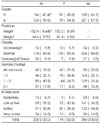Abstract
The purpose of this study is finding the easy way of 4 categories activity level confirmation for estimated energy requirement calculation. Total of 386, 5th and 6th grade primary school students participated. The time spent on 7 kinds of activity were collected for 1 day by the internet program developed. Judged by the activity coefficient, sedentary were 6.7% and 5.1%, low active 33.2% and 40.4%, active 43.8%, and45.5%, and very active 16.3% and 9.0% for boy and girl, respectively. The highest and significant correlation coefficient between activity coefficient and time spent on activities shown were 0.339 in commute activity for boys, and 0.466 in leisure for girls. The sensitivity of the sedentary conformation by commute hour for boys was 0.79, and that of very active was 0.56. The sensitivity of the sedentary conformation by leisure hour for girls was 0.67, and that of very active was 0.63. The sensitivity of low active and active by 7 different types of activity was quite low, 0.04~0.37. The exact agreement of activity level conformed by easy way developed was 30.8% and 33.7%, for boys and girls, respectively. More accurate way to identify 4 categories activity level needs to be developed, especially sensitive to conformation of low active and active levels.
Figures and Tables
Table 2
Time spent on 7 kinds of activity and average activity coefficient of the 7 kinds of activity

References
1. Gibson RS. Principles of Nutritional Assessment. 1990. New York Oxford: Oxford university press;8–14.
2. Kim B. A study on the primary school students' daily activity contents and energy consumption. 2005. Busan National University of Education;MS Thesis.
3. Kim EK, Kim EK, Song JM, Choi HJ, Lee GH. Assessment of activity coefficient, resting energy expenditure and daily energy expenditure in elementary school children. J Korean Diet Assoc. 2006. 12(1):44–54.
4. Kim MJ, Na HJ, Kim Y. Total energy expenditure difference by the class hours in 5th & 6th grade primary school students. J Korean Teach Educ. 2010. 26(6):55–73.
5. Kim MJ, Na HJ, Kim Y. The analysis of activity energy, total energy, and estimated energy expenditures in 5th and 6th grade school students. Korean J Community Nutr. 2011. 16(2):195–205.
6. Kim SH. Institute for Child Study in Kosin University. A study on time frame structure of children. Child Stud. 1996. 5:40–52.
7. Kuminilbo. Being threatened adolescent's health. 2010 October 28. 2010a. 7.
8. Kuminilbo. The editorial column, 2010 March 20. 2010b. 23.
9. Korea Centers for Disease Control & Prevention, The Korean Pediatric Society. 2007 standard growth chart for infant & adolescent. 2008.
10. Selection of 100 'Obesity priority school' among primarymiddle school. KTV news 5. 2008. 01. 12.
http://www.mest.go.kr/web/1173/ko/board/view.do?bbsId=205&boardSeq=2787.
11. Lee HM, Kim EK. Assessment of daily steps, physical activity and activity coefficient of the elementary school children in the rural area. Korean J Community Nutr. 2007. 12(3):361–371.
12. Ministry of Health & Welfare, The Korea Nutrition Society, Korea Food & Drug Administration. Dietary reference intakes for Koreans. 2010. First revision. 25–46.
13. The Korean Nutrition Society. Recommended dietary allowances for Koreans. 2000. 7th revision. 31–42.
14. The Korean Nutrition Society. Dietary reference intakes for Korean. 2005. 15–26.




 PDF
PDF ePub
ePub Citation
Citation Print
Print







 XML Download
XML Download